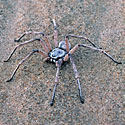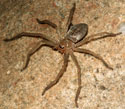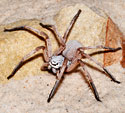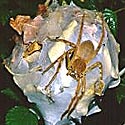|
Family: Sparassidae (huntsman spiders)
[= Heteropodidae]
Life
> Eukaryotes
>
Opisthokonta >
Metazoa
(animals) > Bilateria > Ecdysozoa > Panarthropoda > Tritocerebra >
Arthropoda > Arachnomorpha > Cheliceriformes > Chelicerata > Euchelicerata
> Arachnida > Araneae
> Araneomorpha
Sparassidae spiders are often confused with
the family Theraphosidae (Baboon spiders).
The latter are more bulky and very hairy without the typical ventral markings.
Sparassids can be confused with spiders of the Ctenidae and Pisauridae families.
Sparassids are commonly known as huntsman spiders and large wandering crab
spiders. Afrikaans names are grootdwaalkrapspinnekop and jagspinnekop.
Genera native to southern Africa
Arandisa
One species
(monotypic), Arandisa deserticola, a
Namibian endemic. 10.8mm. |
|
Carparachne
Two species, endemic to dunes of the southern Namib Desert in
Namibia. |
 |
Eusparassus (Rock huntsman
spider)
Eusparassus is probably
the correct generic name for our rock living Olios species. Presently
the only species in the genus is Eusparassus palystiformis, known
from southern Africa. Eusparassus is currently being revised by Peter
Jager and Majid Moradmand. |
|
Leucorchestris (white lady spiders)
Leucorchestris is a psammophilous genus occurring on sand dunes in arid
areas, mainly Namibia but also Angola and the Northern Cape, South Africa. |
 |
Microrchestris
Microrchestris is a Namibian endemic genus with two small-sized
species (10-12mm long). |
|
Olios About 251 species
worldwide, of which 27 are recorded from southern Africa. Olios is a group of smaller spiders
(Body length is 10-14 mm) within the Sparassidae that in general are either
light brown and live under rocks (rupicolus) or green and live on trees
(arboreal). The rock-dwelling species produce a flattish sac retreat and egg sac attached to the
underside of a rock or stone. These spiders share a similar habitat to the
flatties (Selenopidae). |
 |
Orchestrella
Orchestrella is a Namibian endemic genus with two
species (10-18 mm long). |
 |
|
Palystella
Palystella is a Namibian endemic genus with four
species (11-18 mm long).
|
|
Palystes (rain spiders, lizard-eating spiders)
These spiders occur mainly on plants where they hunt predominantly insects
but they also eat geckos. They are large spiders, often mistaken for
baboon spiders, and frequently come
indoors where they frighten people. They can bite but it is no more serious
than a bee sting. Females of the two common species, Palystes castaneus
and Palystes superciliosus, construct an egg case in a bush that
is made of dead leaves and twigs drawn together with silk and with a white
silk covering (see image to the right). |
 |
Panaretella (forest huntsman spiders)
Panaretella
Is a genus of small spiders endemic to the forests from Grahamstown to
northern Kwazulu-Natal. There are five species of forest huntsman spiders.
The retreat is two leaves spun together with silk. Body length 12-18 mm.
They vary from a yellowish to a light reddish brown colour with a
distinctive black mark on either side anterior of the spinnerets. |
|
Parapalystes
Five species, endemic to southern Africa. |
|
Pseudomicrommata
Pseudomicrommata is a monotypic genus with
only
one species, Pseudomicrommata longipes. The spiders are found in areas with Eragrostis
grass where it
constructs its large nest. Pseudomicrommata longipes is easily recognised
by the medial dorsal band running the length of its body. |
|
Genera naturalised in southern Africa
Heteropoda
Heteropoda
venatoria (Brown huntsman spider), a species with a pantropical distribution, has been introduced
to Mozambique and South Africa where it is sometimes reported to take refuse
in houses. |
|
Text by Norman Larsen © |
